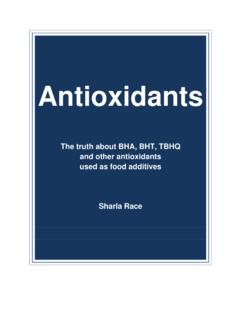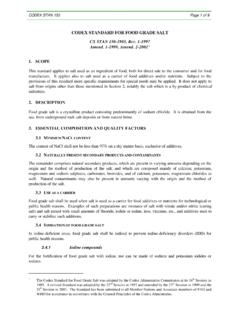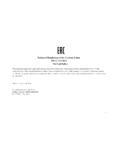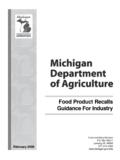Transcription of Harmful Food Additives - Foundation
1 Miscellany35: Harmful food Additives 2006, 2009 Joseph George Caldwell. All rights reserved. Posted at Internet web site . May be copied or reposted for non-commercial use, with attribution. (15 December 2006; updated 23 April 2009, 30 April 2009, 7 May 2009) Commentary on recent news, reading and events of personal interest. Contents Harmful food 1 Harmful food Additives From time to time I have written on Harmful food Additives , including carrageenan, potassium sorbate, and potassium metabisulphite. Here is a summary from previous articles, plus information about another Harmful food additive sodium metabisulphite. Potassium Metabisulphite Potassium metabisulphite .. often used in wines. This additive gives me a dull headache that starts the day after I have a glass of wine and lasts for two days. The additive sulfur dioxide does not cause any problems (see for more information).
2 Here is some information from the entry on postassium metabisulfite from Wikipedia. Potassium metabisulfite, K2S2O5, is a white crystalline powder with a pungent sulfur odour. The main use for the chemical is as an antioxidant or chemical sterilant. It is a sulfite and is chemically very similar to sodium metabisulfite, with which it is sometimes used interchangeably. Potassium metabisulfite is generally preferred out of the two as it does not contribute sodium to the diet. Potassium metabisulfite has a monoclinic crystal structure which decomposes at 190 C, yielding 1 K2O (potassium monoxide), and 2 SO2 (sulfur dioxide) molecules. The potassium monoxide is a solid salt, whereas the sulfur dioxide is a gas. Uses Wine. Potassium metabisulfite is a common wine or must additive, where it forms sulfur dioxide gas (SO2). This both prevents most wild microorganisms from growing, and it acts a potent antioxidant, protecting both the color, and delicate flavors of wine.
3 Beer. Potassium metabisulfite is sometimes used in the brewing industry to inhibit the growth of wild yeasts, bacteria, and fungi. This is called 'stabilizing'. It is used both by homebrewers and commercial brewers alike. It is not used as much for brewing beer, because the wort is almost always boiled, which kills most microorganisms anyway. Potassium Sorbate 2 Potassium sorbate .. used as a preservative in many things, especially in drinks containing citric acid, in apple juice, and in cocktail mixers such as coconut cream. If I ingest it from a drink, it causes a severe pain in the center of my chest, and makes breathing difficult. It is known to have caused fatal reactions. If I ingest it from a non-drink, such as a peach preserve, then it does not cause a severe chest pain, but simply palpitations of the heart for several hours, and pressure and pounding in the head. Update 23 April 2009 I have written previously about Harmful food Additives .
4 The following is an extract from the section Where Has All the Flavor Gone of my article Miscellany 18, posted at . See also the section Australian Wine: No Added Sulfites, No Headaches of my article Miscellany25, posted at . There are plenty of other Additives that are Harmful to human beings. I am allergic to potassium sorbate, which is a preservative often used in citrus drinks, such as apple juice, wine coolers, or cocktail mixes, such as pi a colada or daiquiri mix. This chemical causes me to have severe chest pain, and difficulty breathing. This reaction is not all that uncommon, and can be fatal. If you check the World Wide Web on the Internet (search phrase potassium sorbate ), you will find that some people claim that potassium sorbate has been given a bum rap that it is not at all dangerous. For example, the Lumen Foods website states, It is hard to imagine a naturally-occurring nutrient that has been more maligned or more mischaracterized than potassium sorbate the potassium salt of sorbic acid.
5 ( ). Whatever bad press potassium sorbate has been given is richly deserved. This preservative is very dangerous, and can be fatal. (It took me quite a while to find out that I was allergic to potassium sorbate. Every once in a while I would have a terrible reaction to a soft drink or mix. I would read the labels of what I had drunk, but there were always so many added chemicals that I could not determine which one was causing my problem. Then, one day, in the early 1980s, a friend offered me a wine cooler, which triggered the allergic reaction. To my good fortune, the wine cooler had but a single added ingredient potassium sorbate. My problem was solved. As chance would have it, my children heard a television report a couple of weeks later, discussing the fact that potassium sorbate preservatives could cause fatal reactions.) Unfortunately for me, I am allergic to the sulfites that occur, either added or naturally, in wine.
6 If I take a large glass of red wine, I almost always get a headache that starts the next morning and lasts for the rest of the day, the night, and the next day. Fortunately, I can purchase, in some stores, organic wines, to which no sulfites have been added. Wines from France, Italy, and other foreign countries also tend not to have sulfites added. Champagne appears to have lower levels of sufites. It is a shame that so many poisons are added to our food . No wonder today s food tastes so bad. No wonder there has been such an increase in colon cancer. We are simply pickling our guts. [End of update.] Here is information extracted from the Wikipedia on potassium sorbate. 3 Potassium sorbate is a mild preservative. Its primary use is as a food preservative (E number 202). Its molecular formula is C6H7O2K and its systematic name is potassium (E,E)-hexa-2,4-dienoate. Potassium sorbate is effective in a variety of applications including food , wine, and personal care.
7 Usage Potassium sorbate is used to inhibit molds, and yeasts in many foods, such as cheese, wine, yogurt, and baked goods. It can also be found in the ingredients list of many dried fruit products. In addition, herbal dietary supplement products generally contain potassium sorbate, which acts to prevent mold and microbes and to increase shelf life, and is used in such tiny quantities that there is no known adverse health effects. Labeling of this preservative reads as "potassium sorbate" on the ingredient statement. Also, it is used in many personal care products to inhibit the development of microorganisms for shelf stability. Some manufacturers are using this preservative as a replacement for parabens. Also known affectionately as "wine stabilizer", potassium sorbate produces sorbic acid when added to wine. It serves two purposes. When active fermentation has ceased and the wine racked the final time after clearing, potassium sorbate will render any surviving yeast incapable of multiplying.
8 Yeast living at that moment can continue fermenting any residual sugar into CO2 and alcohol, but when they die no new yeast will be present to cause future fermentation. When a wine is sweetened before bottling, potassium sorbate is used to prevent refermentation when used in conjunction with potassium metabisulfite. It is primarily used with sweet wines and sparkling wines, but may be added to table wines which exhibit difficulty in maintaining clarity after fining. Some molds (notably some Trichoderma and Penicillium strains) and yeasts are able to detoxify sorbates by decarboxylation, producing 1,3-pentadiene. The pentadiene manifests as a typical odor of kerosene or petroleum. Synthesis Potassium sorbate is the potassium salt of sorbic acid. Toxicology This gentle preservative is considered to be safe and mild because of its long term safety record and non-toxic profile. Potassium sorbate is non-irritating and non-sensitizing.
9 Although allergic reactions to potassium sorbate is very rare and it is well tolerated when administered internally, sorbic acid is a possible skin irritant, and may cause rashes, asthma and hyperactivity. In rare cases, this can translate to an allergic reaction to potassium sorbate. It may also affect children s health, behaviour and learning and can be found on lists of Additives to avoid, with alternatives being refrigeration, freezing and ascorbates 300-304. [End of Wikipedia extract.] The Wikipedia article is flat-out wrong on the gentleness of potassium sorbate. It causes severe reactions in some people, and can be fatal. Carrageenan 4 Carrageenan .. used as a thickener in many products, such as ice cream and yogurt. Causes stomache upset, deterioration of mammary-gland tissues. In some formulations, is carcinogenic (see for more information). Here is some information from Wikipedia on carrageenan.
10 Carrageenans or carrageenins are a family of linear sulphated polysaccharides extracted from red seaweeds. The name is derived from a type of seaweed that is abundant along the Irish coastline near the village of Carragheen. Gelatinous extracts of carrageen seaweed (also known as Irish moss) have been used as food Additives for hundreds of years. Research has raised concerns about the health implications of carrageenan consumption. Uses Carrageenans are large, highly flexible molecules which curl forming helical structures. This gives them the ability to form a variety of different gels at room temperature. They are widely used in the food and other industries as thickening and stabilizing agents. A particular advantage is that they are thixotropic they thin under shear stress and recover their viscosity once the stress is removed. This means that they are easy to pump but stiffen again afterwards.








